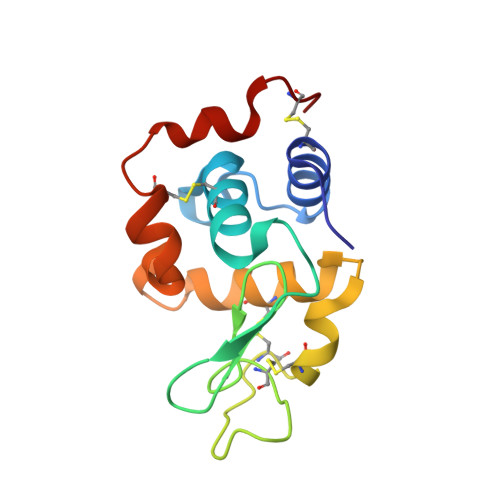Weak protein-cationic co-ion interactions addressed by X-ray crystallography and mass spectrometry.
Benas, P., Auzeil, N., Legrand, L., Brachet, F., Regazzetti, A., Ries-Kautt, M.(2014) Acta Crystallogr D Biol Crystallogr 70: 2217-2231
- PubMed: 25084340
- DOI: https://doi.org/10.1107/S1399004714011304
- Primary Citation of Related Structures:
4NEB, 4NFV, 4NG1, 4NG8, 4NGI, 4NGJ, 4NGK, 4NGL, 4NGO, 4NGV, 4NGW, 4NGY, 4NGZ - PubMed Abstract:
The adsorption of Rb(+), Cs(+), Mn(2+), Co(2+) and Yb(3+) onto the positively charged hen egg-white lysozyme (HEWL) has been investigated by solving 13 X-ray structures of HEWL crystallized with their chlorides and by applying electrospray ionization mass spectrometry (ESI-MS) first to dissolved protein crystals and then to the protein in buffered salt solutions. The number of bound cations follows the order Cs(+) < Mn(2+) ≃ Co(2+) < Yb(3+) at 293 K. HEWL binds less Rb(+) (qtot = 0.7) than Cs(+) (qtot = 3.9) at 100 K. Crystal flash-cooling drastically increases the binding of Cs(+), but poorly affects that of Yb(3+), suggesting different interactions. The addition of glycerol increases the number of bound Yb(3+) cations, but only slightly increases that of Rb(+). HEWL titrations with the same chlorides, followed by ESI-MS analysis, show that only about 10% of HEWL binds Cs(+) and about 40% binds 1-2 Yb(3+) cations, while the highest binding reaches 60-70% for protein binding 1-3 Mn(2+) or Co(2+) cations. The binding sites identified by X-ray crystallography show that the monovalent Rb(+) and Cs(+) preferentially bind to carbonyl groups, whereas the multivalent Mn(2+), Co(2+) and Yb(3+) interact with carboxylic groups. This work elucidates the basis of the effect of the Hofmeister cation series on protein solubility.
Organizational Affiliation:
Laboratoire de Cristallographie et RMN Biologiques, Faculté des Sciences Pharmaceutiques et Biologiques, Université Paris Descartes, UMR 8015 CNRS, 4 Avenue de l'Observatoire, 75270 Paris CEDEX 06, France.
















